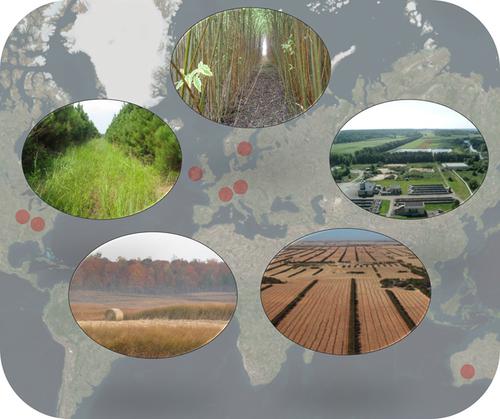当前位置:
X-MOL 学术
›
WIREs Energy Environ.
›
论文详情
Our official English website, www.x-mol.net, welcomes your feedback! (Note: you will need to create a separate account there.)
Multifunctional perennial production systems for bioenergy: performance and progress
Wiley Interdisciplinary Reviews: Energy and Environment ( IF 6.1 ) Pub Date : 2020-05-11 , DOI: 10.1002/wene.375 Oskar Englund 1, 2, 3 , Ioannis Dimitriou 4 , Virginia H. Dale 5 , Keith L. Kline 6 , Blas Mola‐Yudego 7 , Fionnuala Murphy 8 , Burton English 9 , John McGrath 10 , Gerald Busch 11 , Maria Cristina Negri 12 , Mark Brown 13 , Kevin Goss 14 , Sam Jackson 15 , Esther S. Parish 6 , Jules Cacho 12 , Colleen Zumpf 12 , John Quinn 12 , Shruti K. Mishra 12
Wiley Interdisciplinary Reviews: Energy and Environment ( IF 6.1 ) Pub Date : 2020-05-11 , DOI: 10.1002/wene.375 Oskar Englund 1, 2, 3 , Ioannis Dimitriou 4 , Virginia H. Dale 5 , Keith L. Kline 6 , Blas Mola‐Yudego 7 , Fionnuala Murphy 8 , Burton English 9 , John McGrath 10 , Gerald Busch 11 , Maria Cristina Negri 12 , Mark Brown 13 , Kevin Goss 14 , Sam Jackson 15 , Esther S. Parish 6 , Jules Cacho 12 , Colleen Zumpf 12 , John Quinn 12 , Shruti K. Mishra 12
Affiliation

|
As the global population increases and becomes more affluent, biomass demands for food and biomaterials will increase. Demand growth is further accelerated by the implementation of climate policies and strategies to replace fossil resources with biomass. There are, however, concerns about the size of the prospective biomass demand and the environmental and social consequences of the corresponding resource mobilization, especially concerning impacts from the associated land‐use change. Strategically integrating perennials into landscapes dominated by intensive agriculture can, for example, improve biodiversity, reduce soil erosion and nutrient emissions to water, increase soil carbon, enhance pollination, and avoid or mitigate flooding events. Such “multifunctional perennial production systems” can thus contribute to improving overall land‐use sustainability, while maintaining or increasing overall biomass productivity in the landscape. Seven different cases in different world regions are here reviewed to exemplify and evaluate (a) multifunctional production systems that have been established to meet emerging bioenergy demands, and (b) efforts to identify locations where the establishment of perennial crops will be particularly beneficial. An important barrier towards wider implementation of multifunctional systems is the lack of markets, or policies, compensating producers for enhanced ecosystem services and other environmental benefits. This deficiency is particularly important since prices for fossil‐based fuels are low relative to bioenergy production costs. Without such compensation, multifunctional perennial production systems will be unlikely to contribute to the development of a sustainable bioeconomy.
中文翻译:

多年生多功能生物能源生产系统:性能和进步
随着全球人口的增加和变得更加富裕,对食物和生物材料的生物量需求将会增加。通过实施气候政策和战略以生物质替代化石资源,需求增长进一步加速。但是,人们对潜在生物量需求的规模以及相应的资源动员所带来的环境和社会后果,尤其是相关土地利用变化的影响,感到担忧。从战略上将多年生植物整合到以集约农业为主的景观中,例如可以改善生物多样性,减少土壤侵蚀和水的养分排放,增加土壤碳含量,增强授粉,避免或减轻洪水事件。这样的“多功能多年生生产系统”因此可以有助于改善总体土地利用的可持续性,同时保持或提高景观的整体生物量生产率。本文回顾了世界不同地区的七种不同情况,以举例说明和评估(a)为满足新兴的生物能源需求而建立的多功能生产系统,以及(b)努力确定多年生作物的种植特别有利的地点。广泛实施多功能系统的一个重要障碍是缺乏市场或政策,无法补偿生产者增强的生态系统服务和其他环境利益。由于与生物能源生产成本相比,基于化石燃料的价格较低,因此这一缺陷尤为重要。
更新日期:2020-05-11
中文翻译:

多年生多功能生物能源生产系统:性能和进步
随着全球人口的增加和变得更加富裕,对食物和生物材料的生物量需求将会增加。通过实施气候政策和战略以生物质替代化石资源,需求增长进一步加速。但是,人们对潜在生物量需求的规模以及相应的资源动员所带来的环境和社会后果,尤其是相关土地利用变化的影响,感到担忧。从战略上将多年生植物整合到以集约农业为主的景观中,例如可以改善生物多样性,减少土壤侵蚀和水的养分排放,增加土壤碳含量,增强授粉,避免或减轻洪水事件。这样的“多功能多年生生产系统”因此可以有助于改善总体土地利用的可持续性,同时保持或提高景观的整体生物量生产率。本文回顾了世界不同地区的七种不同情况,以举例说明和评估(a)为满足新兴的生物能源需求而建立的多功能生产系统,以及(b)努力确定多年生作物的种植特别有利的地点。广泛实施多功能系统的一个重要障碍是缺乏市场或政策,无法补偿生产者增强的生态系统服务和其他环境利益。由于与生物能源生产成本相比,基于化石燃料的价格较低,因此这一缺陷尤为重要。



























 京公网安备 11010802027423号
京公网安备 11010802027423号